Closure of the Eastern Paleo-Asian Ocean: Evidence from Permian–Triassic Volcanic Rocks in the Northern Margin of the North China Craton
Abstract
1. Introduction
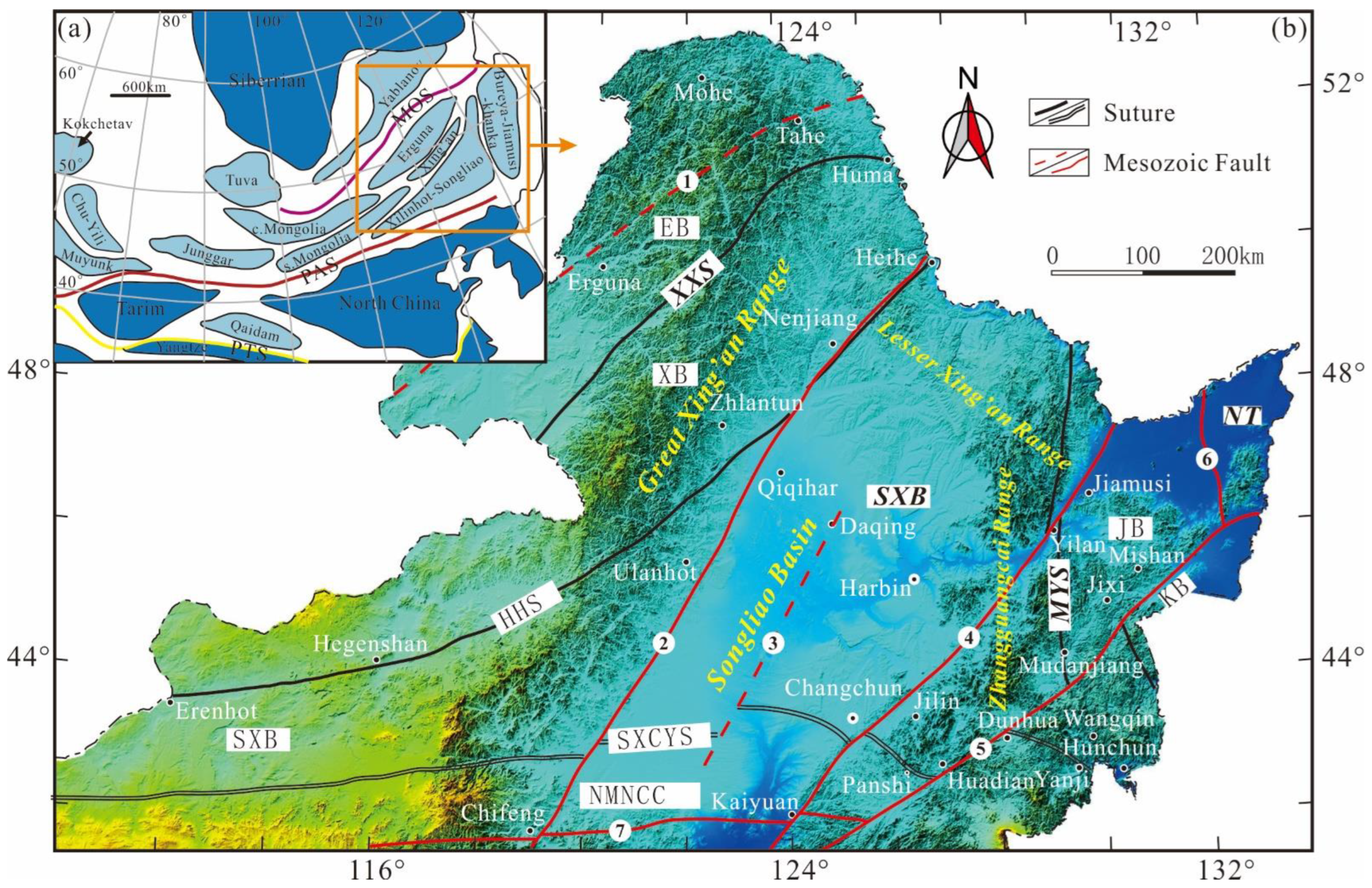
2. Geological Setting and Sample Descriptions
3. Analytical Methods
3.1. Zircon U-Pb Dating
3.2. Whole-Rock Geochemistry
3.3. Zircon Hf Isotope Analysis
3.4. Method of Crustal Thickness Estimation
4. Results
4.1. Zircon U-Pb Geochronology
4.2. Whole-Rock Major and Trace Element Compositions

4.3. Zircon Lu-Hf Isotopes
4.4. Crustal Thickness Estimation
5. Discussion
5.1. Early Permian–Middle Triassic Magmatism in the Faku-Yanji Area
5.2. The Nature of Magma Source
5.2.1. Origin of the Bachagou Andesites
5.2.2. Origin of the Chaijialing Andesites
5.2.3. Origin of the Chaijialing Dacites
5.3. Petrogenesis
5.3.1. The Bachagou Andesites
5.3.2. The Chaijialing Andesites
5.3.3. The Chaijialing Dacites
5.4. Tectonic Setting
5.4.1. Early Permian (293–273 Ma) Tectonic Evolution
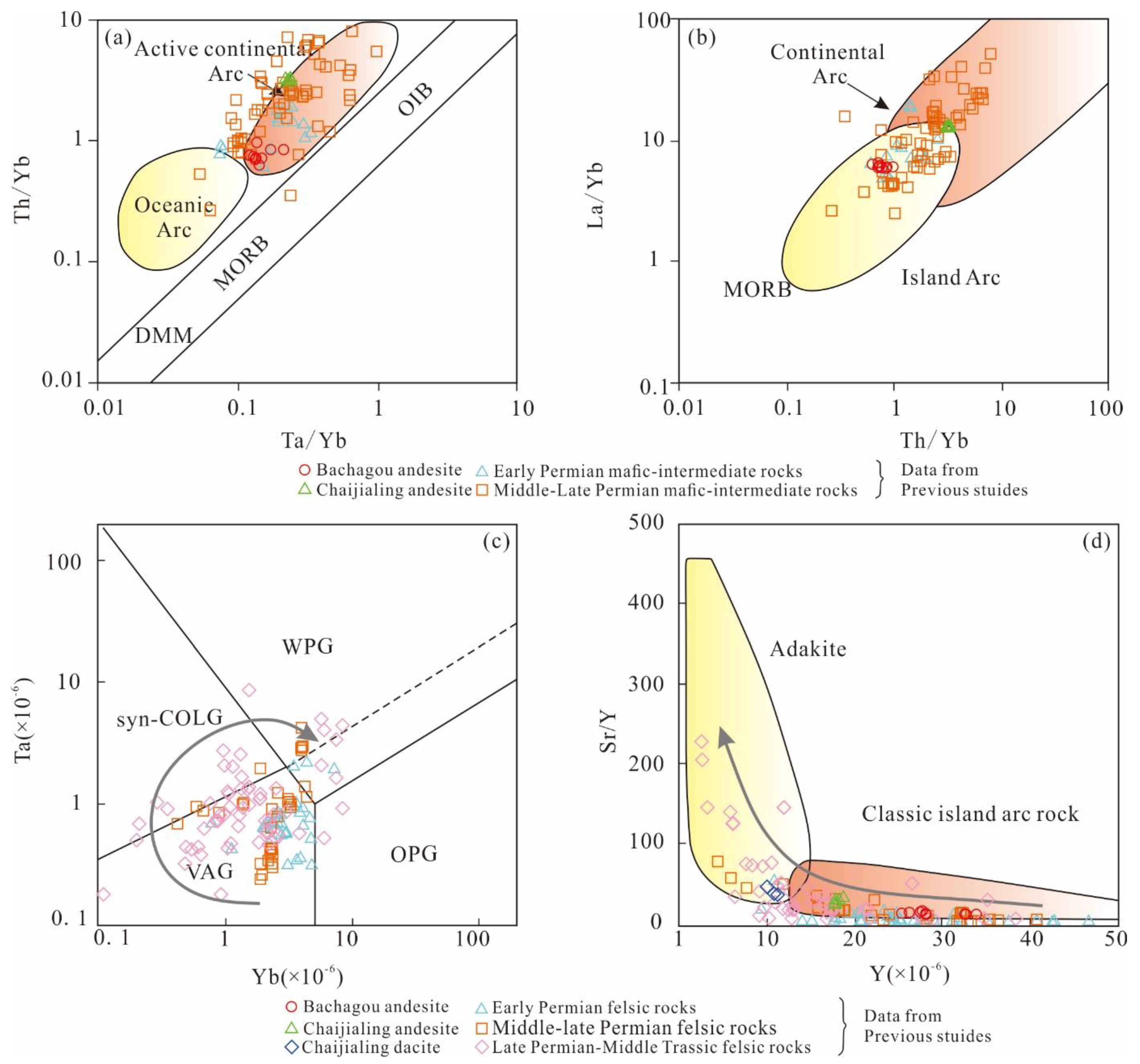
5.4.2. Middle-Late Permian (270–252 Ma) Tectonic Evolution
5.4.3. Late Permian–Middle Triassic (251–240 Ma) Tectonic Evolution
6. Conclusions
Supplementary Materials
Author Contributions
Funding
Data Availability Statement
Acknowledgments
Conflicts of Interest
References
- Xiao, W.J.; Shu, L.S.; Gao, J.; Xiong, X.L.; Wang, J.B.; Guo, S.J.; Li, J.Y.; Sun, M. Geodynamic Processes of the Central Asian Orogenic Belt and its Metallogeny. Xingjiang Geol. 2008, 26, 4–8, (In Chinese with English abstract). [Google Scholar]
- Xiao, W.J.; Song, D.F.; Windley, B.F.; Li, J.L.; Han, C.M.; Wan, B.; Zhang, J.E.; Ao, S.J.; Zhang, Z.Y. Accretionary processes and metallogenesis of the Central Asian Orogenic Belt: Advances and perspective. Sci. China Earth Sci. 2020, 3, 329–361, (In Chinese with English abstract). [Google Scholar] [CrossRef]
- Liu, Y.J.; Feng, Z.Q.; Jiang, L.W.; Li, W.M.; Guan, Q.B.; Liang, C.Y. Ophiolite in the eastern Central Asian Orogenic Belt, NE China. Acta Petrol. Sin. 2019, 35, 3017–3047, (In Chinese with English abstract). [Google Scholar]
- Liu, Y.J.; Li, W.M.; Feng, Z.Q.; Wen, Q.B.; Neubauer, F.; Liang, C.Y. A review of the Paleozoic tectonics in the eastern part of Central Asian Orogenic Belt. Gondwana Res. 2017, 43, 123–148. [Google Scholar] [CrossRef]
- Liu, Y.J.; Li, W.M.; Ma, Y.F.; Feng, Z.Q.; Guan, Q.B.; Li, S.Z.; Chen, Z.X.; Liang, C.Y.; Wen, Q.B. An orocline in the eastern Central Asian Orogenic Belt. Earth Sci. Rev. 2021, 221, 103808. [Google Scholar] [CrossRef]
- Sengör, A.M.C.; Natal’in, B.A.; Burtman, V.S. Evolution of the Altaid tectonic collage and Palaeozoic crustal growth in Eurasia. Nature 1993, 364, 299–307. [Google Scholar] [CrossRef]
- Jahn, B.M.; Wu, F.Y.; Hong, D.W. Important crustal growth in the Phanerozoic: Isotopic evidence of granitoids from East central Asia. J. Earth Syst. Sci. 2000, 109, 5–20. [Google Scholar] [CrossRef]
- Windley, B.F.; Alexeiev, D.; Xiao, W.J.; Kroöner, A.; Badarch, G. Tectonic models for accretion of the Central Asian Orogenic Belt. J. Geol. Soc. Lond. 2007, 164, 31–47. [Google Scholar] [CrossRef]
- Safonova, I.; Seltmann, R.; Kröner, A.; Gladkochub, D.; Schulmann, K.; Xiao, W.J.; Kim, J.Y.; Komiya, T.; Sun, M. A new concept of continental construction in the Central Asian Orogenic Belt. Episodes 2011, 34, 186–196. [Google Scholar] [CrossRef]
- Wu, F.Y.; Sun, D.Y.; Ge, W.C.; Zhang, Y.B.; Grant, M.L.; Wilde, S.A.; Jahn, B.M. Geochronology of the Phanerozoic granitoids in northeastern China. J. Asian. Earth. Sci. 2011, 41, 1–30. [Google Scholar] [CrossRef]
- Ge, W.C.; Wu, F.Y.; Zhou, C.Y.; Zhang, J.H. Mineralization ages and geodynamic implications of porphyry Cu-Mo deposits in the east of Xing-Meng orogenic belt. Chinese Sci. Bull. 2007, 52, 2407–2417. [Google Scholar] [CrossRef]
- Xu, B.; Zhao, P.; Bao, Q.Z.; Zhou, Y.H.; Wang, Y.Y.; Luo, Z.W. Preliminary study on the pre-Mesozoic tectonic unit division of the Xing-Meng Orogenic Belt(XMOB). Acta Petrol. Sin. 2014, 30, 1841–1857, (In Chinese with English abstract). [Google Scholar]
- Shao, J.A.; Tang, K.D. The Ophiolite Melange in Kaishantun, Jilin Province, China. Acta Petrol. Sin. 1995, 11, 212–220, (In Chinese with English abstract). [Google Scholar]
- Xu, W.L.; Pei, F.P.; Gao, F.H.; Yang, D.B.; Bu, Y.J. Zircon U-Pb Age from Basement Granites in Yishu Graben and its tectonic implications. J. Earth Sci. 2008, 33, 145–149, (In Chinese with English abstract). [Google Scholar]
- Zhang, X.H.; Xue, F.H.; Yuan, L.L.; Ma, Y.G.; Wilde, S.A. Late Permian appinite-granite complex from northwestern Liaoning, North China Craton: Petrogenesis and tectonic implications. Lithos 2012, 155, 201–217. [Google Scholar] [CrossRef]
- Dobretsov, N.L.; Buslov, M.M.; Vernikovsky, V.A. Neoproterozoic to early ordovician evolution of the Paleo-Asian Ocean: Implications to the break-up of rodinia. Gondwana Res. 2003, 6, 143–159. [Google Scholar] [CrossRef]
- Kheraskova, T.N.; Bush, V.A.; Didenko, A.N.; Samygin, S.G. Breakup of Rodinia and early stages of evolution of the paleoasian ocean. Geotectonics 2010, 44, 3–24. [Google Scholar] [CrossRef]
- Khain, E.V.; Bibikova, E.V.; Salnikova, E.B.; Kröner, A.; Gibsher, A.S.; Didenko, A.N.; Degtyarev, K.E.; Fedotova, A.A. The palaeo-asian ocean in the Neoproterozoic and early palaeozoic: New geochronologic data and palaeotectonic reconstructions. Precambi. Res. 2003, 122, 329–358. [Google Scholar] [CrossRef]
- Li, J.Y. Permian geodynamic setting of northeast China and adjacent regions: Closure of the Paleo-Asian Ocean and subduction of the Paleo-pacific plate. J. Asian. Earth. Sci. 2006, 26, 207–224. [Google Scholar] [CrossRef]
- Li, S.L.; Ouyang, Z.Y. Tectonic framework and evolution of Xing’Anling-Mongolian orogenic belt(XMOB) and its adjacent region. Mar. Geol. Quat. Geol. 1998, 18, 45–54, (In Chinese with English abstract). [Google Scholar]
- Xiao, W.J.; Windley, B.F.; Hao, J.; Zhai, M.G. Accretion leading to collision and the Permian Solonker suture, Inner Mongolia, China: Termination of the central Asian orogenic belt. Tectonics 2003, 22, 1–20. [Google Scholar] [CrossRef]
- Xiao, W.J.; Windley, B.F.; Huang, B.C.; Han, C.M.; Yuan, C.; Chen, H.L.; Sun, M.; Sun, S.; Li, J.L. End-Permian to mid-Triassic termination of the accretionary processes of the southern Altaids: Implications for the geodynamic evolution, Phanerozoic continental growth and metallogeny of Central Asia. Int. J. Earth. Sci. 2009, 98, 1219–1220. [Google Scholar] [CrossRef]
- Zhang, S.H.; Zhao, Y.; Liu, J.M.; Hu, J.M.; Song, B.; Liu, B.; Wu, H. Geochronology, geochemistry and tectonic setting of the Late Paleozoic-Early Mesozoic magmatism in the northern margin of the North China Block: A preliminary review. Acta Pertol. Mineral. 2010, 29, 824–842, (In Chinese with English abstract). [Google Scholar]
- Liu, J.F.; Li, J.Y.; Chi, X.G.; Feng, Q.W.; Hu, Z.C.; Zhou, K. Early Devonian felsic volcanic rocks related to the arc-continent collision on the northern margin of North China craton-evidences of zircon U-Pb dating and geochemical characteristics. Geol. Bull. China 2013, 32, 267–278. [Google Scholar]
- Zhang, C.; Guo, W.; Xu, Z.Y.; Liu, Z.H.; Liu, Y.J.; Lei, C.C. Study on geochronology, petrogenesis and tectonic implications of monzogranite from the Yanbian area, eastern Jilin Province. Acta Petrol. Sin. 2014, 30, 512–526, (In Chinese with English abstract). [Google Scholar]
- Shi, Y.; Chen, J.S.; Wei, M.H.; Shi, S.S.; Zhang, C.; Zhang, L.D.; Hao, Y.J. Evolution of eastern segment of the Paleo-Asian Ocean in the Late Paleozoic: Geochronology and geochemistry constraints of granites in Faku area, North Liaoning, NE China. Acta Petrol. Sin. 2020, 36, 3287–3308. [Google Scholar]
- Shi, Y.; Liu, Z.H.; Liu, Y.J.; Shi, S.S.; Wei, M.H.; Yang, J.J.; Gao, T. Late Paleozoic-Early Mesozoic southward subduction-closure of the Paleo-Asian OceanProof from geochemistry and geochronology of Early Permian-Late Triassic felsic intrusive rocks from North Liaoning, NE China. Lithos 2019, 346–347, 105165. [Google Scholar] [CrossRef]
- Liu, J.; Zhang, J.; Liu, Z.H.; Yin, C.Z.; Zhao, C.; Yu, X.Y.; Chen, Y.; Tian, Y.; Dong, Y. Petrogenesis of Permo-Triassic intrusive rocks in Northern Liaoning Province, NE China: Implications for the closure of the eastern Paleo-Asian Ocean. Int. Geol. Rev. 2019, 9, 1–27. [Google Scholar] [CrossRef]
- Guan, Q.B.; Liu, Z.H.; Liu, Y.J.; Li, S.Z.; Wang, S.J.; Chen, Z.X.; Zhang, C. A tectonic transition from closure of the Paleo-Asian Ocean to subduction of the Paleo-Pacific Plate: Insights from early Mesozoic igneous rocks in eastern Jilin Province, NE China. Gondwana Res. 2020, 102, 332–353. [Google Scholar] [CrossRef]
- Jing, Y.; Yang, H.; Ge, W.C.; Dong, Y.; Ji, Z.; Bi, J.H.; Zhou, H.Y.; Xing, D.H. When did the final closure occur of the eastern Paleo-Asian Ocean: Constraints from the latest Early-Middle Triassic adakitic granites in the southeastern Central Asian Orogenic Belt. Gondwana Res. 2022, 103, 146–171. [Google Scholar] [CrossRef]
- Xu, B.; Charvet, J.; Chen, J. Middle Paleozoic convergent orogenic belts in western Inner Mongolia (China): Framework, kinematics, geochronology and implications for the tectonic evolution of the Central Asian Orogenic Belt. Gondwana Res. 2013, 23, 1342–1364. [Google Scholar] [CrossRef]
- Shao, J.A.; He, G.Q.; Tang, K.D. The evolution of Permian continental crust in northern part of North China. Acta Petrol. Sin. 2015, 31, 47–55, (In Chinese with English abstract). [Google Scholar]
- Zhao, G.C.; Wang, Y.J.; Huang, B.C.; Dong, Y.P.; Li, S.Z.; Zhang, G.W.; Yu, S. Geological reconstructions of the East Asian blocks: From the breakup of Rodinia to the assembly of Pangea. Earth Sci. Rev. 2018, 186, 262–286. [Google Scholar] [CrossRef]
- Shen, X.L.; Du, Q.X.; Han, Z.Z.; Song, Z.G.; Han, C.; Zhong, W.J.; Ren, X. Constraints of zircon U-Pb-Hf isotopes from Late Permian-Middle Triassic flora-bearing strata in the Yanbian area (NE China) on a scissor-like closure model of the Paleo-Asian Ocean. J. Asian. Earth. Sci. 2019, 183, 103964. [Google Scholar] [CrossRef]
- Sun, D.Y.; Wu, F.Y.; Zhang, Y.B.; Gao, S. The final closing time of the west Lamulun River-Changchun-Yanji plate suture zone. J. Jilin Univ. 2004, 34, 174–181, (In Chinese with English abstract). [Google Scholar]
- Cao, H.H.; Xu, W.L.; Pei, F.P.; Wang, Z.W.; Wang, F.; Wang, Z.J. Zircon U-Pb geochronology and petrogenesis of the Late Paleozoic-Early Mesozoic intrusive rocks in the eastern segment of the northern margin of the North China Block. Lithos 2013, 170–171, 191–207. [Google Scholar] [CrossRef]
- Song, D.F.; Xiao, W.J.; Windley, B.F.; Mao, Q.G.; Ao, S.J.; Wang, Y.C.; Li, R. Closure of the Paleo-Asian Ocean in the Middle-Late Triassic (Ladinian-Carnian): Evidence from Provenance Analysis of Retroarc Sediments. Geophys. Res. Lett. 2021, 48, e2021GL094276. [Google Scholar] [CrossRef]
- Zhang, X.H.; Zhang, H.F.; Simon, A.W.; Yang, Y.H.; Chen, H.H. Late Permian to Early Triassic mafic to felsic intrusive rocks from North Liaoning, North China: Petrogenesis and implications for Phanerozoic continental crustal growth. Lithos 2010, 117, 283–306. [Google Scholar] [CrossRef]
- Zhang, X.H.; Su, W.J.; Wang, H. Zircon SHRIMP geochronology of the Faku tectonics in the northern Liaoning Province: Implications for the northern boundary of the North China Craton. Acta Petrol. Sin. 2005, 21, 135–142, (In Chinese with English abstract). [Google Scholar]
- Zhang, X.H.; Zhang, H.F.; Zhai, M.G.; Wilde, S.A.; Xie, L.W. Geochemistry of middle Triassic gabbros from northern Liaoning, North China: Origin and tectonic implications. Geol. Mag. 2009, 146, 540–551. [Google Scholar] [CrossRef]
- Zhang, N.; Wang, C.B.; Liu, Z.H.; Xu, Z.Y.; Li, G.; Xuan, Y.F.; Guo, Y.; Wang, C. Tectonic evolution of the Late Paleozoic-Early Mesozoic orogenic belt in the eastern margin of the northern margin of the North China Block: Evidence from meta-volcanic rocks of Jianshanzi, northern Liaoning Province. Acta Petrol. Sin. 2022, 38, 2323–2344. [Google Scholar]
- Claoue-Long, J.; Compston, W.; Roberts, J.; Fanning, C.M. Two Carboniferous ages: A comparison of shrimp zircon dating with conventional zircon ages and 40Ar/39Ar analysis. Geochronology 1995, 5, 3–31. [Google Scholar]
- Ludwig, K.R. User’s manual for Isoplot 3.0: A geochronological toolkit for Microsoft Excel. Berkeley Geochronol. Cent. Spec. Publ. 2003, 4, 25–32. [Google Scholar]
- Liu, Y.S.; Hu, Z.C.; Gao, S.; Gunther, D.; Xu, J.; Gao, C.G.; Chen, H.H. In situ analysis of major and trace elements of anhydrous minerals by LA-ICP-MS without applying an internal standard. Chem. Geol. 2008, 257, 34–43. [Google Scholar] [CrossRef]
- Bouvier, A.; Vervoort, J.D.; Patchett, P.J. The Lu–Hf and Sm–Nd isotopic composition of Chur: Constraints from unequilibrated chondrites and implications for the bulk composition of terrestrial planets. Earth Planet. Sci. Lett. 2008, 273, 48–57. [Google Scholar] [CrossRef]
- Blichert-Toft, J.; Albarède, F. The Lu–Hf geochemistry of chondrites and the evolution of the mantle–crust system. Earth Planet. Sci. Lett. 1997, 148, 243–258. [Google Scholar] [CrossRef]
- Griffin, W.L.; Pearson, N.J.; Belousova, E.; Jackson, S.E.; Achterbergh, E.; Reilly, S.Y.; Shee, S.R. The Hf isotope composition of cratonic mantle: LAM-MC-ICPMS analysis of zircon megacrysts in kimberlites. Geochim. Cosmochim. Acta 2000, 64, 133–147. [Google Scholar] [CrossRef]
- Griffin, W.L.; Wang, X.; Jackson, S.E.; Pearson, N.J.; O’Reilly, S.Y.; Xu, X.; Zhou, X. Zircon chemistry and magma mixing, se China: Insitu analysis of Hf isotopes, Tonglu and Pingtan igneous complexes. Lithos 2002, 61, 237–269. [Google Scholar] [CrossRef]
- Chapman, J.B.; Ducea, M.N.; Decelles, P.G.; Profeta, L. Tracking changes in crustal thickness during orogenic evolution with Sr/Y: An example from the North American Cordillera. Geology 2015, 43, 919–922. [Google Scholar] [CrossRef]
- Chiaradia, M. Crustal thickness control on Sr/Y signatures of recent arc magmas: An Earth scale perspective. Sci. Rep. 2015, 5, 8115. [Google Scholar] [CrossRef]
- Profeta, L.; Ducea, M.N.; Chapman, J.B.; Paterson, S.R.; Gonzales, S.M.H.; Kirsch, M.; Petrescu, L.; Decells, P.G. Quantifying crustal thickness over time in magmatic arcs. Sci Rep. 2015, 5, 1–7. [Google Scholar] [CrossRef] [PubMed]
- Hu, F.Y.; Ducea, M.N.; Liu, S.W.; Chapman, J.B. Quantifying Crustal Thickness in Continental Collisional Belts: Global Perspective and a Geologic Application. Sci. Rep. 2017, 7, 7058. [Google Scholar] [CrossRef] [PubMed]
- Tang, M.; Ji, W.Q.; Chu, X.; Chu, X.; Wu, A.B.; Chen, C. Reconstructing crustal thickness evolution from europium anomalies in detrital zircons. Geology 2020, 49, 76–80. [Google Scholar] [CrossRef]
- Li, C.M. A Review on the Minerageny and Situ Microanalytical Dating Techniques of Zircons. Geol. Surv. Res. 2009, 33, 161–174. [Google Scholar]
- Winchester, J.A.; Floyd, P.A. Geochemical discrimination of different magma series and their differentiation products using immobile elements. Chem. Geol. 1977, 20, 325–343. [Google Scholar] [CrossRef]
- Bas, M.J.; Maitre, R.W.; Streckeisen, A.; Zanettin, B. A chemical classification of volcanic rocks based on the total alkali-silica diagram. J. Petrol. 1986, 27, 745–750. [Google Scholar] [CrossRef]
- Peccerillo, A.; Taylor, S.R. Geochemistry of Eocene calc-alkaline volcanic rocks from the Kastamonu area, Northern Turkey. Contrib. Mineral. Petrolo. 1976, 58, 63–81. [Google Scholar] [CrossRef]
- Maniar, P.D.; Piccoli, P.M. Tectonic discrimination of granitoids. Geol. Soc. Am. Bull. 1989, 101, 635–643. [Google Scholar] [CrossRef]
- Zhang, Q.; Qian, Q.; Zhai, M.G.; Jin, W.J.; Wang, Y.; Jian, P.; Wang, Y.L. Geochemistry, petrogenesis and geodynamic implications of sanukite. Acta Petrol. Mineral. 2005, 24, 117–125, (In Chinese with English abstract). [Google Scholar]
- Zhang, Q.; Wang, Y.; Wang, Y.L. On the relationship between adakite and its tectonic setting. Geotect. Metallog. 2003, 27, 101–108, (In Chinese with English abstract). [Google Scholar]
- Sun, S.S.; McDonough, W.F. Chemical and isotopic systematics of oceanic basalts: Implications for mantle composition and processes. Geol. Soc. Spec. Publ. 1989, 42, 313–345. [Google Scholar] [CrossRef]
- Yang, J.H.; Wu, F.Y.; Shao, J.A.; Wilde, S.A.; Xie, L.W.; Liu, X.M. Constraints on the timing of the uplift of the Yanshan Fold and Thrust Belt, North China. Earth Planet. Sci. Lett. 2007, 246, 336–352. [Google Scholar] [CrossRef]
- Zhang, Y.B.; Wu, F.Y.; Wilde, S.A.; Zhai, M.G.; Lu, X.P.; Sun, D.Y. Zircon U-Pb ages and tectonic implications of ‘Early Paleozoic’ granitoids at Yanbian, Jilin Province, northeast China. Island Arc 2004, 13, 484–505, (In Chinese with English abstract). [Google Scholar]
- Cao, H.H.; Xu, W.L.; Pei, F.P.; Guo, P.Y.; Wang, F. Permian tectonic evolution of the eastern section of the northern margin of the North China Plate: Constraints from zircon U-Pb geochronology and geochemistry of the volcanic rocks. Acta Petrol. Sin. 2012, 28, 2733–2750, (In Chinese with English abstract). [Google Scholar]
- Cao, H.H.; Xu, W.L.; Pei, F.P.; Zhang, X.Z. Permian tectonic evolution in Southwestern Khanka Massif: Evidence from Zircon U-Pb Chronology, Hf isotope and Geochemistry of Gabbro and Diorite. Acta Geol. Sin. 2011, 85, 1390–1402. [Google Scholar]
- Guo, F.; Li, H.X.; Fan, W.M.; Li, J.Y.; Zhao, L.; Huang, M.W. Variable sediment flux in generation of Permian sudduction-related mafic intrusions from the Yanbian region, NE China. Lithos 2016, 261, 195–215. [Google Scholar] [CrossRef]
- Zhou, Z.B.; Pei, F.P.; Wang, Z.W.; Cao, H.H.; Lu, S.M.; Xu, W.L.; Zhou, H. Geochronology and geological implications of Fangniugou volcanic rocks in Yitong area, central Jilin Province. Global Geol. 2018, 37, 46–55, (In Chinese with English abstract). [Google Scholar]
- Jing, Y.; Ge, W.C.; Dong, Y.; Yang, H.; Ji, Z.; Bi, J.H.; Zhou, H.Y.; Xing, D.H. Early-Middle Permian southward subduction of the eastern Paleo-Asian Ocean: Constraints from geochronology and geochemistry of intermediate-acidic volcanic rocks in the northern margin of the North China Craton. Lithos 2020, 364, 105491. [Google Scholar] [CrossRef]
- Chen, Y.J.; Peng, Y.J.; Liu, Y.W.; Sun, G.; Matthew, W. Progress in the study of Chronostratigraphy of the “Qinghezhen Group”. Geol. Rev. 2006, 52, 170–177. [Google Scholar]
- Li, C.D.; Zhang, F.Q.; Miao, L.C.; Xie, H.Q.; Xu, Y.W. Zircon SHRIMP geochronology and geochemistry of Late Permian high-Mg andesites in Seluohe area, Jilin province, China. Acta Petrol. Sin. 2007, 23, 767–776, (In Chinese with English abstract). [Google Scholar]
- Wang, Z.J.; Xu, W.L.; Pei, F.P.; Cao, H.H. Middle Permian-Early Triassic mafic magmatism and its tectonic implication in the eastern section of the southern margin of the Xing’an-Mongolian Orogenic Belt, NE China: Constraints from zircon U-Pb geochronology and geochemistry. Geol. Bull. China 2013, 32, 374–387, (In Chinese with English abstract). [Google Scholar]
- Wang, Z.J.; Xu, W.L.; Pei, F.P.; Wang, Z.W.; Yu, L.; Cao, H.H. Geochronology and geochemistry of middle Permian-Middle Triassic intrusive rocks from central-eastern Jilin Province, NE China: Constraints on the tectonic evolution of the eastern segment of the Paleo-Asian Ocean. Lithos 2015, 238, 13–25. [Google Scholar] [CrossRef]
- Gu, C.C.; Zhu, G.; Li, Y.J.; Su, N.; Xiao, S.Y.; Zhang, S.; Liu, C. Timing of deformation and location of the eastern Liaoyuan Terrane, NE China: Constraints on the final closure time of the Paleo-Asian Ocean. Gondwana Res. 2018, 60, 194–212. [Google Scholar] [CrossRef]
- Song, Z.G.; Han, Z.Z.; Gao, L.H.; Geng, H.Y.; Li, X.P.; Meng, F.X.; Han, M.; Zhong, W.J.; Li, J.J.; Du, Q.X.; et al. Permo-Triassic evolution of the southern margin of the Central Asian Orogenic Belt revisited: Insights from Late Permian igneous suite in the Daheishan Horst, NE China. Gondwana Res. 2018, 56, 23–50. [Google Scholar] [CrossRef]
- Liu, J.; Liu, Z.H.; Li, S.C.; Zhao, C.; Wang, C.J.; Peng, B.Y.; Yang, Z.J.; Dou, S.Y. Geochronology and geochemistry of Triassic intrusive rocks in Kaiyuan area of the eastern section of the northern margin of North China. Acta Petrol. Sin. 2016, 32, 2739–2756, (In Chinese with English abstract). [Google Scholar]
- Ma, X.H.; Chen, C.J.; Zhao, J.X.; Qiao, S.L.; Zhou, Z.H. Late Permian intermediate and felsic intrusions in the eastern Central Asian Orogenic Belt: Final-stage magmatic record of Paleo-Asian Oceanic subduction? Lithos 2019, 326–327, 265–278. [Google Scholar] [CrossRef]
- Shi, Y.; Liu, Z.Y.; Xu, Z.Y.; Wang, X.A.; Zhang, C.; Liu, W.Z.; Chen, X. Isotopic chronology and geochemistry of the Hercynian Yongxin granitoid in Longjing, Jilin province. Geol. Resour. 2013, 22, 6–13, (In Chinese with English abstract). [Google Scholar]
- Fu, C.L.; Sun, D.Y.; Zhang, X.Z.; Wei, H.Y.; Gou, J. Discovery and geological significance of the Triassic high-Mg diorites in Hunchu area, Jilin Province. Acta Petrol. Sin. 2010, 26, 1089–1102, (In Chinese with English abstract). [Google Scholar]
- Guan, Q.B.; Li, S.C.; Zhng, C.; Shi, Y.; Li, P.C. Zircon U-Pb dating, geochemistry and geological significance of the I-type granites in Helong area, the eastern section of the southern margin of Xing-Meng Orogenic Belt. Acta Petrol. Sin. 2016, 32, 2690–2706, (In Chinese with English abstract). [Google Scholar]
- Yuan, L.L.; Zhang, X.H.; Xue, F.H.; Liu, Y.H.; Zong, K.Q. Late Permian high-Mg andesite and basalt association from northern Liaoning, North China: Insights into the final closure of the Paleo-Asian ocean and the orogen-craton boundary. Lithos 2016, 258–259, 58–76. [Google Scholar] [CrossRef]
- Yang, D.G.; Sun, D.Y.; Gou, J.; Hou, X.G. U-Pb ages of zircons from Mesozoic intrusive rocks in the Yanbian area, Jilin Province NE China: Transition of the Paleo-Asian ocean regime to the circum-Pacific tectonic regime. J. Asian Earth Sci. 2017, 143, 171–190. [Google Scholar] [CrossRef]
- Liu, S.; Hu, R.Z.; Gao, S.; Feng, C.X.; Feng, G.Y.; Coulson, L.M.; Li, C.; Wang, T.; Qi, Y.Q. Zircon U-Pb age and Sr-Nd-Hf isotope geochemistry of Permian granodiorite and associated gabbro in the Songliao Block, NE China and implications for growth of juvenile crust. Lithos 2010, 114, 423–436. [Google Scholar] [CrossRef]
- Rudnick, R.L.; Gao, S. Composition of the continental crust. The crust 2003, 3, 1–64. [Google Scholar]
- Wu, F.Y.; Li, X.H.; Zheng, Y.F.; Gao, S. Lu-Hf isotopic systematics and their applications in petrology. Acta Petarol. Sin. 2007, 23, 185–220, (In Chinese with English abstract). [Google Scholar]
- Rapp, R.P.; Watson, E.B. Dehydration Melting of Metabasalt at 8–32 kbar: Implications for Continental Growth and Crust-Mantle Recycling. J. Petrol. 1995, 36, 891–931. [Google Scholar] [CrossRef]
- Bonin, B. Do coeval mafic and felsic magmas in post-collisional towithin-Black regions necessarily imply two constrasting, mantle and crustal, sources? A review. Lithos 2004, 78, 1–24. [Google Scholar] [CrossRef]
- Guo, F.; Nakamuru, E.; Fan, W.M.; Kobayoshi, K.; Li, C.W. Generation of Palaeocene adakitic by magma mixing in Yanji area, NE China. J. Petrol. 2007, 48, 661–692. [Google Scholar] [CrossRef]
- Kelemen, P.B. Genesis of high Mg# andesites and the continental crust. Contrib. Mineral. Petrol. 1995, 120, 1–19. [Google Scholar]
- Petford, N.; Atherton, M. Na-rich partial melts from newly underplated basaltic crust: The Cordillera Blanca Batholith, Peru. J. Petrol. 1996, 37, 1491–1521. [Google Scholar] [CrossRef]
- Li, W.; Chen, J.L.; Dong, Y.P.; Xu, X.Y.; Li, P.Z.; Liu, X.M.; He, D.F. Early Paleozoic subduction of the Paleo-Asian Ocean: Zircon U-Pb geochronological and geochemical evidence from the Kalatag high-Mg andesites, East Tianshan. Acta Petrol. Sin. 2016, 32, 505–521, (In Chinese with English abstract). [Google Scholar]
- Ji, Z.; Ge, W.C.; Yang, H.; Bi, J.H.; Yu, Q.; Dong, Y. The Late Triassic Andean-type andesites from the central Great Xing’an Range: Products of the southward subduction of the Mongol-Okhotsk oceanic plate. Acta Petrol. Sin. 2018, 34, 2917–2930. [Google Scholar]
- Hanyu, T.; Tastumi, Y.; Nakai, S.; Chang, Q.; Miyazaki, T.; Sato, K.; Tani, K.; Shibate, T.; Yoshida, T. Contribution of slab melting and slab dehydration to magmatism in the NE Japan arc for the last 25Myr: Constraints from geochemistry. Geochem. Geophys. Geosystems 2006, 7, 1–29. [Google Scholar] [CrossRef]
- Kelemen, P.B.; Hanghoj, K.; Greene, A.R. One view of the Geochemistry of Subduction-Related Magmatic Arcs, with an Emphasis on Primitive Andesite and Lower Crust. Treatise Geochem. 2007, 3–9, 1–10. [Google Scholar]
- Tang, G.J.; Wang, Q. High-Mg andesites and their geodynamic implications. Acta Petrol. Sin. 2010, 26, 2495–2512, (In Chinese with English abstract). [Google Scholar]
- Kamei, A.; Owada, M.; Nagao, T.; Shiraki, K. High-Mg diorites derived from sanukitic HMA magmas, Kyushu Island, southwest Japan arc: Evidence from clinopyroxene and whole rock compositions. Lithos 2004, 75, 359–371. [Google Scholar] [CrossRef]
- Rogers, G.; Saunders, A.D.; Terrell, D.J.; Verma, S.P.; Marriner, G.F. Geochemistry of Holocene volcanic rocks associated with ridge subduction in Baja California, Mexico. Nature 1985, 315, 389–392. [Google Scholar] [CrossRef]
- Yogodzinski, G.M.; Kay, R.W.; Volynets, O.N.; Koloskov, A.V.; Kay, S.M. Magnesian andesite in the western Aleutian Komandorsky region: Implications for slab melting and processes in the mantle wedge. GSA Bulletin 1995, 107, 505–519. [Google Scholar] [CrossRef]
- Zhang, H.X.; Niu, H.C.; Yu, X.Y.; SATO, H.; ITO, J.; Shan, Q. Geochemical characteristics of the Shaerbulake boninites and their tectonic significance, Fuyun County, northern Xinjiang, China. Geochemical 2003, 32, 155–160, (In Chinese with English abstract). [Google Scholar]
- Manya, S.; Maboko, M.; Nakamura, E. The geochemistry of high-Mg andesite and associated adakitic rocks in the Musoma-Mara Greenstone Belt, northern Tanzania: Possible evidence for Neoarchaean ridge subduction? Precambrian Res. 2007, 159, 241–259. [Google Scholar] [CrossRef]
- Mukasa, S.B.; Blatter, D.L.; Andronikov, A.V. Mantle peridotite xenoliths in andesite lava at El Peon, central Mexican Volcanic Belt: Isotopic and trace element evidence for melting and metasomatism in the mantle wedge beneath an active arc. Earth Planet. Sci. Lett. 2007, 260, 37–55. [Google Scholar] [CrossRef]
- Tatsumi, Y. Geochemical modelling of partial melting of subconducting sediments and subsequent melt-mantle interaction: Generation of high-Ma andesites in the Setouchi volcanic belt, southwest Japan. Geology 2001, 29, 323–326. [Google Scholar] [CrossRef]
- Shimoda, G.; Tatsumi, Y.; Nohda, S.; Ishizaka, K.; Jahn, B.M. Setouchi high-Mg andesites revisited: Geochemical evidence for melting of subducting sediments. Earth Planet. Sci. Lett. 1998, 160, 479–492. [Google Scholar] [CrossRef]
- Tatsumi, Y. High-Mg andesites in the Setouchi volcanic belt, southwestern Japan: Analogy to Archean magmatism and continental crust formation? Annu. Rev. Earth Planet Sci. 2006, 34, 467–499. [Google Scholar] [CrossRef]
- Tiepolo, M.; Tribuzio, R.; Langone, A. High-Mg Andesite Petrogenesis by Amphibole Crystallization and Ultramafic Crust Assimilation: Evidence from Adamello Hornblendites (Central Alps, Italy). J. Petrol. 2011, 52, 1011–1045. [Google Scholar] [CrossRef]
- Streck, M.J.; Leeman, P.; Chesley, J. High-magnesian andesite from Mount Shasta: A product of magma mixing and contamination, not a primitive mantle melt. Geology 2007, 35, 351–354. [Google Scholar] [CrossRef]
- Stolper, E.; Newman, S. The role of water in the petrogenesis of Mariana trough magmas. Earth Planet. Sci. Lett. 1994, 121, 293–325. [Google Scholar] [CrossRef]
- Kessel, R.; Schmidt, M.W.; Ulmer, P.; Pettke, T. Trace element signature of subduction-zone fluids, melts and supercritical liquids at 120–180 km depth. Nature 2005, 437, 724–727. [Google Scholar] [CrossRef]
- Zhao, G.C. Meramorphic evolution of major tectonic units in the basement of the North China Craton: Key issues and discussion. Acta Petrol. Sin. 2009, 25, 1772–1792, (In Chinese with English abstract). [Google Scholar]
- La Flèche, M.R.; Camire, G.; Jenner, G.A. Geochemistry of post-Acadian, Carboniferous continental intraplate basalts from the Maritimes Basin, Magdalen islands, Quebec, Canada. Chem. Geol. 1998, 148, 115–136. [Google Scholar] [CrossRef]
- Zhao, H.; Liao, Q.N.; Li, S.Z.; Xiao, D.; Wang, G.C.; Guo, R.L.; Xue, Z.Q.; Li, X.Y. Early Paleozoic tectonic evolution and magmatism in the Eastern Tianshan, NW China: Evidence from geochronology and geochemistry of volcanic rocks. Gondwana Res. 2020, 102, 354–371. [Google Scholar] [CrossRef]
- Defant, M.J.; Drummond, M.S. Derivation of some modern arc magmas by melting of young subducted lithosphere. Nature 1990, 347, 662–665. [Google Scholar] [CrossRef]
- Castillo, P.R. Adakite petrogenesis. Lithos 2012, 134–135, 304–316. [Google Scholar]
- Martin, H.; Smithies, R.H.; Rapp, R.; Moyen, J.F.; Champion, D. An overview of adakite, Tonalite-Trondhjemite-Granodiorite (TTG), and sanukitoid: Relationship and some implications for crustal evolution. Lithos 2005, 79, 1–24. [Google Scholar]
- Castillo, P.R.; Janney, P.E.; Solidum, R.U. Petrology and geochemistry of Camiguin island, southern Philippines: Insights to the source of adakites and other lavas in a complex arc setting. Contrib. Miner. Petrol. 1999, 134, 33–51. [Google Scholar] [CrossRef]
- Macpherson, C.G.; Dreher, S.T.; Thirlwall, M.F. Adakites without slab melting: High pressure differentiation of island arc magma, Mindanao, the Philippines. Earth Planet. Sci. Lett. 2006, 243, 581–593. [Google Scholar] [CrossRef]
- Gao, S.; Rudnick, R.L.; Yuan, H.L.; Liu, X.M.; Liu, Y.S.; Xu, W.L.; Ayers, L.; Wang, X.C.; Wang, Q.H. Recycling lower continental crust in the North Chian craton. Nature 2004, 432, 892–897. [Google Scholar] [CrossRef]
- Xu, W.L.; Wang, Q.H.; Wan, D.Y.; Guo, J.H.; Pei, F.P. Mesozoic adakitic rocks from the Xuzhou-Suzhou area, eastern China: Evidence for partial melting of delaminated lower continental crust. J. Asian Earth Sci. 2006, 27, 454–464. [Google Scholar] [CrossRef]
- Chung, S.L.; Liu, D.Y.; Ji, J.Q.; Chu, M.F.; Lee, H.Y.; Wen, D.Y.; Lo, C.H.; Lee, T.Y.; Qian, Q.; Zhang, Q. Adakites from continental collision zones: Melting of thickened lower crust beneath southern Tibet. Geology 2003, 31, 1021–1024. [Google Scholar]
- Wang, Q.; McDermott, F.; Xu, J.F.; Bellon, H.; Zhu, Y.T. Cenozoic K-rich adakitic volcanic rocks in the Hohxil area, northern Tibet: Lower-crustal melting in an intracontinental setting. Geology 2005, 33, 465–468. [Google Scholar] [CrossRef]
- Huo, T.F.; Yang, D.B.; Shi, J.M.; Yang, H.T.; Xu, W.L.; Wang, F.; Lu, Y. Early Cretaceous Fengshan and Caishan high-Mg# adakitic rocks from the Xuzhou-Huaibei area, central China: Interaction between mantle peridotite and melt derived from partial melting of delaminated lower continental crust. Acta Petrol. Sin. 2018, 34, 1669–1684. [Google Scholar]
- Deng, J.F.; Xiao, Q.H.; Su, S.G.; Liu, C.; Zhao, G.C.; Wu, Z.X.; Liu, Y. Ingeous Petrotectonic Assemblages and Tectonic Settings: A Discussion. Geol. J. China Univ. 2007, 13, 392–402. [Google Scholar]
- Shervais, J.W. Ti-V plots and the petrogenesis of modern and ophiolitic lavas. Earth Planet. Sci. Lett. 1982, 59, 101–118. [Google Scholar] [CrossRef]
- Pearce, J.A.; Harris, N.B.W.; Tindle, A.G. Trace element discrimination diagrams for the tectonic interpretation of granitic rocks. J. Petrol. 1984, 25, 956–983. [Google Scholar] [CrossRef]
- Yu, Q.; Ge, W.C.; Yang, H.; Zhao, G.C.; Zhang, Y.L.; Su, L. Petrogenesis of late Paleozoic volcanic rocks from the Daheshen Formation in central Jilin Province, NE China, and its tectonic implications: Constraints from geochronology, geochemistry and Sr-Nd-Hf isotopes. Lithos 2014, 192–195, 116–131. [Google Scholar] [CrossRef]
- Mu, R.T.; Pei, F.P.; Shi, Y.Q.; Wei, J.Y. Genesis of Early Permian Volcanic Rocks in the Yitong Area, Central Jilin: Constraints from Zircon U-Pb Geochronology and Whole-Rock Geochemistry. J. Jilin Univ. 2022; in press. (In Chinese with English abstract). [Google Scholar]
- Whalen, J.B.; Currie, K.L.; Chappell, B.W. A-type granites: Geochemical characteristics, discrimination and petrogenesis. Contrib. Mineral. Petrolo. 1987, 95, 407–419. [Google Scholar] [CrossRef]
- King, P.L.; White, A.J.R.; Chappell, B.W.; Allen, C.M. Characterization and origin of aluminous A-type granites from the Lachlan Fold Belt, Southeastern Australia. J. Petrol. 1997, 38, 371–391. [Google Scholar] [CrossRef]
- Bonin, B. A-type granites and related rocks: Evolution of a concept, problems and prospect. Lithos 2007, 97, 1–29. [Google Scholar] [CrossRef]
- Ducea, M.N.; Saleeby, J.B.; Bergantz, G. The Architecture, Chemistry, and Evolution of Continental Magmatic Arcs. Annu. Rev. Earth Planet. Sci. 2015, 43, 10.1–10.33. [Google Scholar] [CrossRef]
- Wang, T.; Tong, Y.; Xiao, W.J.; Guo, L.; Windley, B.F.; Donskaya, T.; Li, S.; Tserendash, N.; Zhang, J.J. Rollback, scissor-like closure of the Mongol-Okhotsk Ocean and formation of an orocline: Magmatic migration based on a large archive of age data. Nat. Sci. Rev. 2022, 9, nwab210. [Google Scholar] [CrossRef]
- Xing, Y.L.; Ren, J.L.; Peng, Y.J.; Sun, X.Q. Ending of the mountain-building movement of Xing’an-Mongolian-Ji-Hei Orogenic Belt in NorthEast China: Evidence from Late Triassic molasse(geotectonic phase). Geol. Resour. 2011, 20, 413–419, (In Chinese with English abstract). [Google Scholar]
- Wang, B.; Zhou, J.B.; Wilde, S.A.; Zhang, X.Z.; Ren, S.M. The timing of final closure along the changchun–yanji suture zone: Constraints from detrital zircon u–pb dating of the triassic dajianggang formation ne china. Lithos 2016, 261, 216–231. [Google Scholar] [CrossRef]
- Zhou, J.B.; Cao, J.Q.; Han, W.; Li, G.Y. The Changchun-Yanji Suture Zone: Nature and tectonic implications. Acta Petrol. Sin. 2020, 36, 635–643, (In Chinese with English abstract). [Google Scholar]
- Xi, A.H.; Ren, H.M.; Zhang, B.F.; Zhi, X.J. Isotopic Chronology of the hulan group and its geological significance in the Central Jilin Province. J. Chang. Univ. Sci. Technol. 2003, 33, 15–18, (In Chinese with English abstract). [Google Scholar]
- Liu, Z.H.; Wang, C.; Song, J.; Gao, X.; Sun, L.N. 40Ar-39Ar dating and its tectonic of the Hulan Group at the northern margin of the North China Plate. Acta Petrol. Sin. 2016, 32, 2757–2764, (In Chinese with English abstract). [Google Scholar]
- Liu, J.Y.; Xi, A.H.; Ge, Y.H.; Sun, H.T.; Gong, P.H. Mineralization Age of the No3 Ore-bearing Intrusion and Its Petrological Significance in Hongqiling Cu-Ni Sulfide Deposits Jilin Province. J. Jilin Univ. 2010, 40, 321–326, (In Chinese with English abstract). [Google Scholar]
- Zhang, D.H.; Huang, B.C.; Zhao, G.C.; Meert, J.G.; Williams, S.; Zhou, T.H. Quantifying the extent of the paleo-asian ocean during the late carboniferous to Early Permian. Geophys. Res. Lett. 2021, 48, e2021GL094498. [Google Scholar] [CrossRef]
- Zhang, D.H.; Zhao, G.C.; Huang, B.C.; Zhao, J.; Zhao, Q. Palaeomagnetic constraints on a Late permian to Early triassic final closure of the palaeo-asian ocean. Geol. J. 2023, 58, 903–919. [Google Scholar] [CrossRef]
- Sun, Y.W.; Ding, H.S.; Liu, H.; Zhang, D.J.; Gong, F.H.; Zheng, Y.J. Fossil plants from the Guadalupian Yujiabeigou Formation in the North margin of North China Plate and their tectonic implications. J. Jilin Univ. 2016, 46, 1268–1283, (In Chinese with English abstract). [Google Scholar]

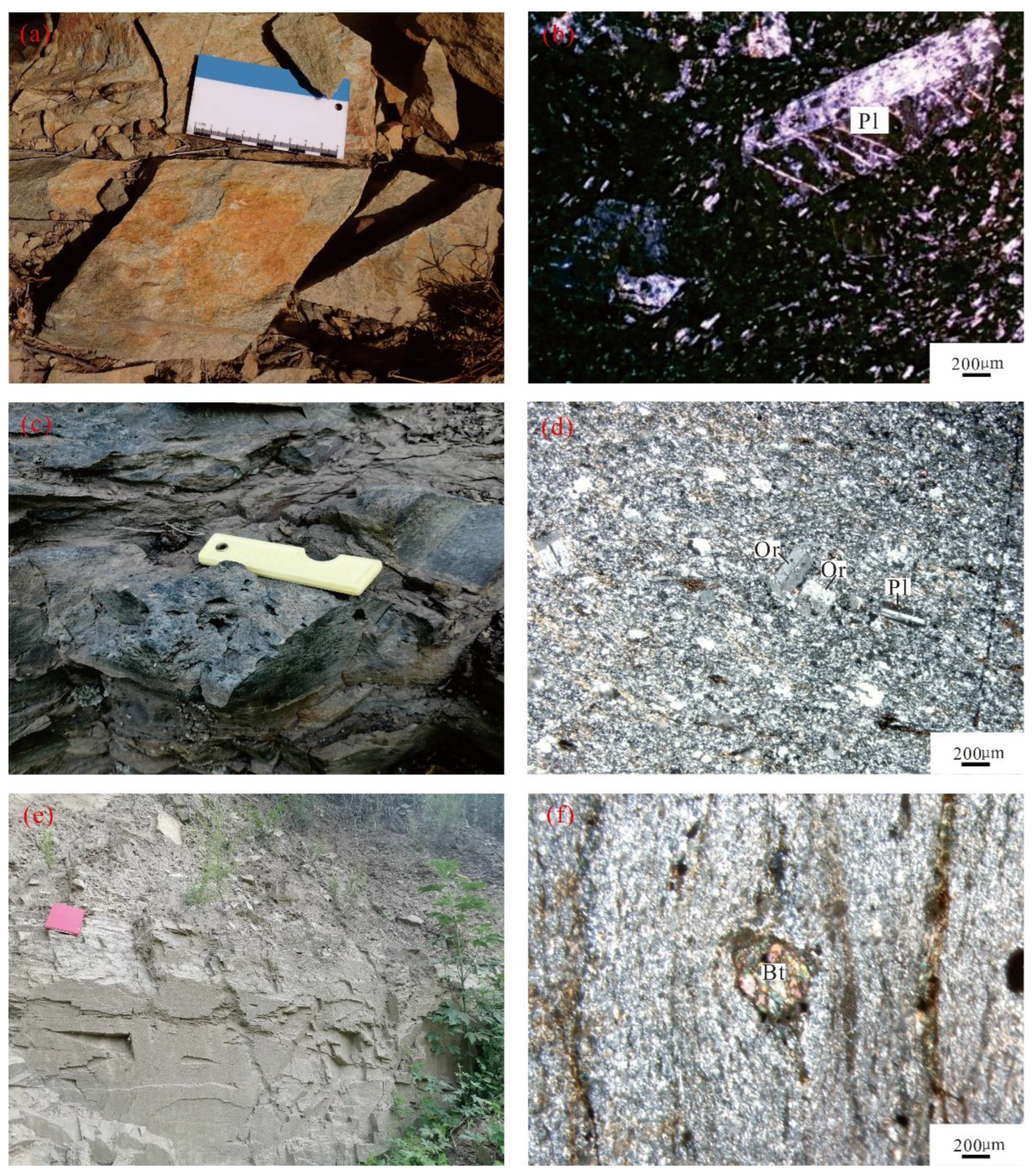
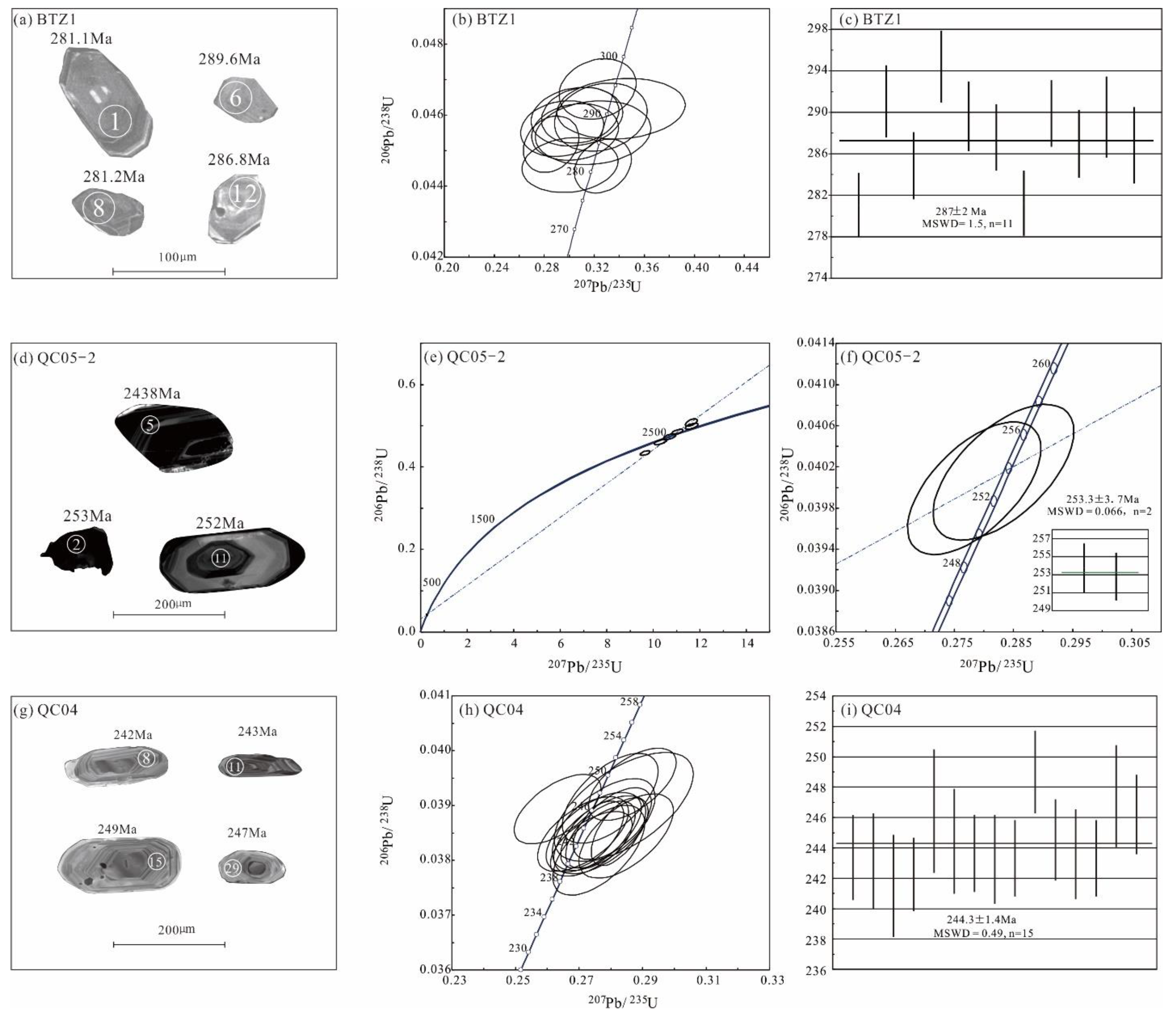
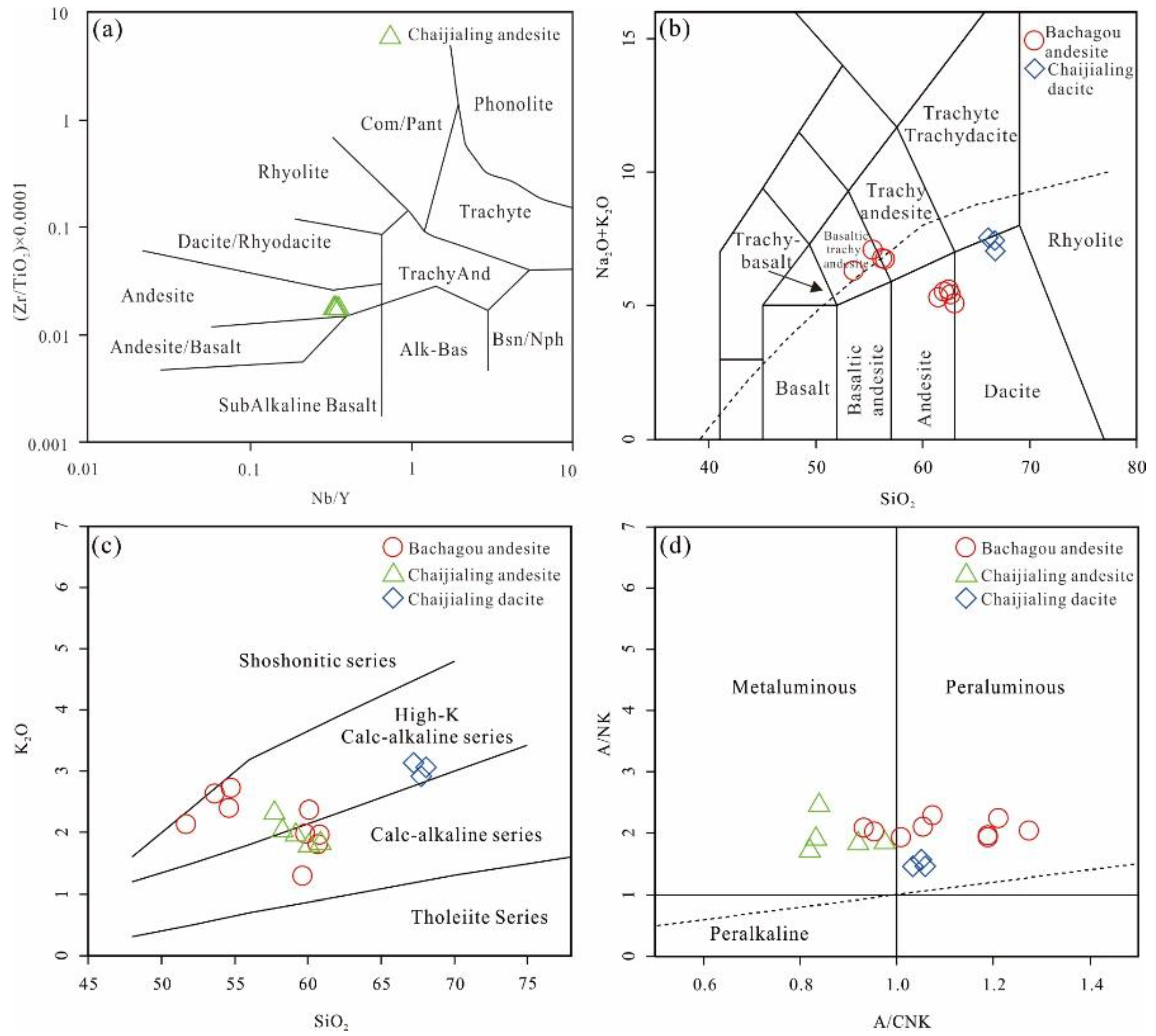
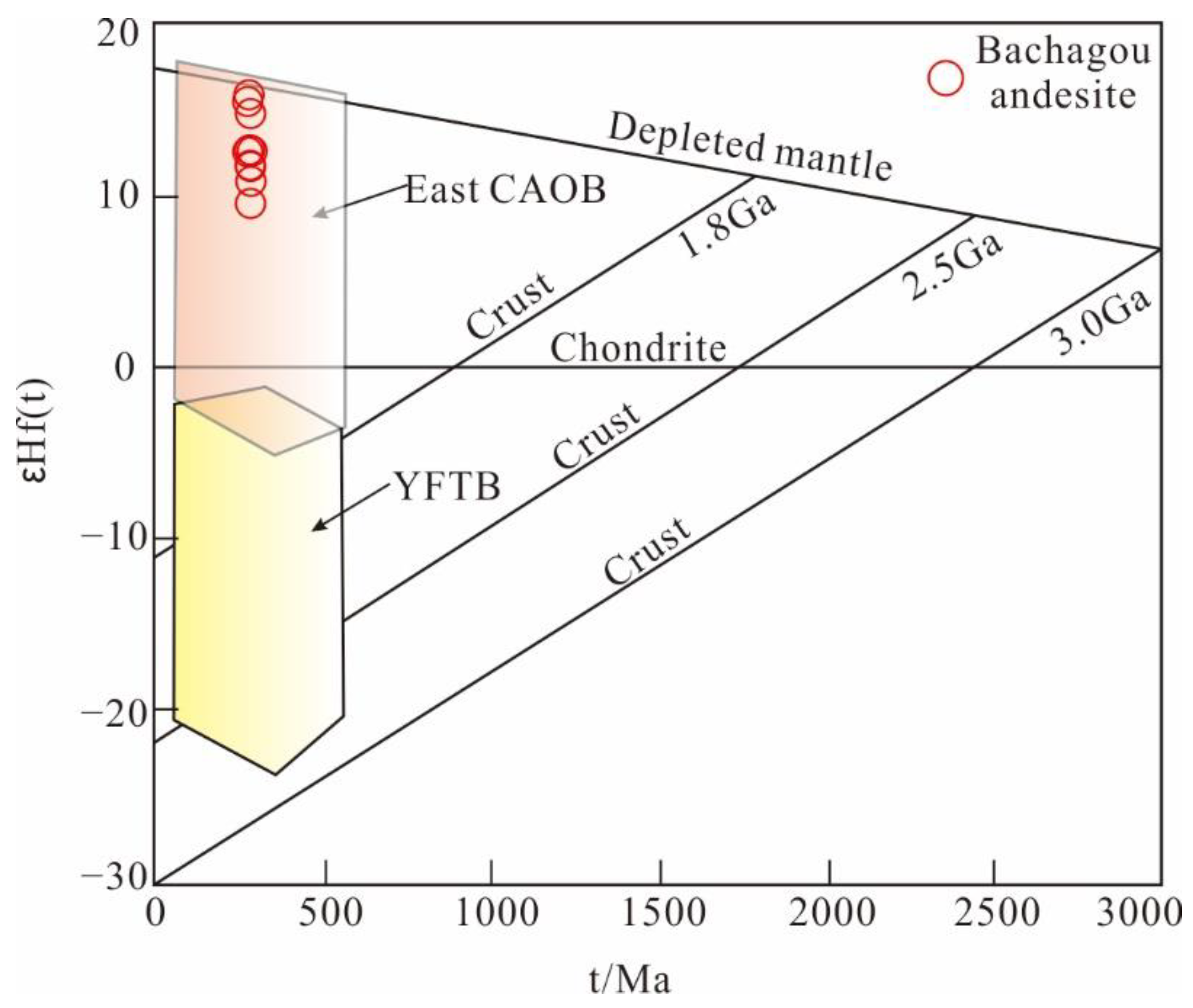
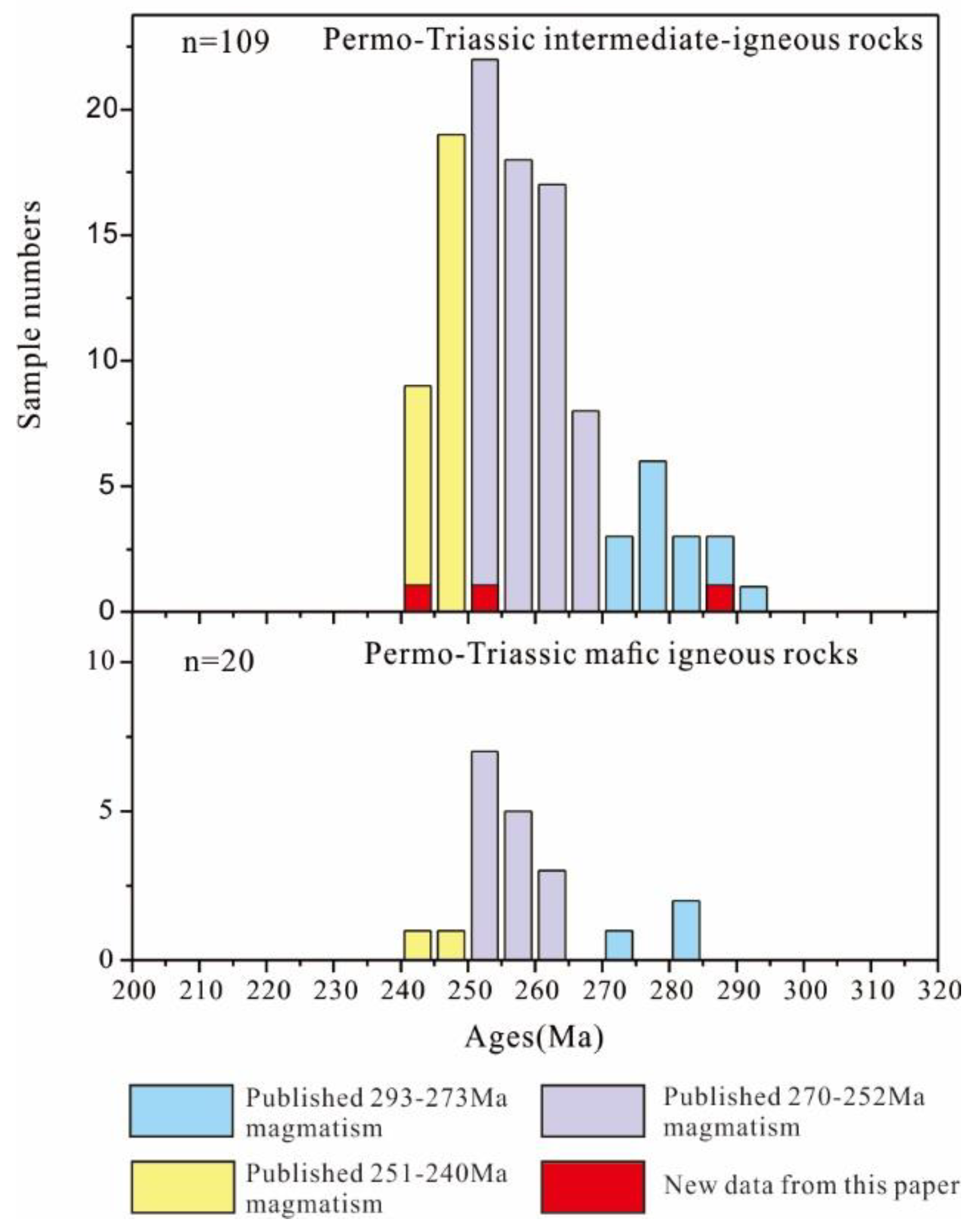
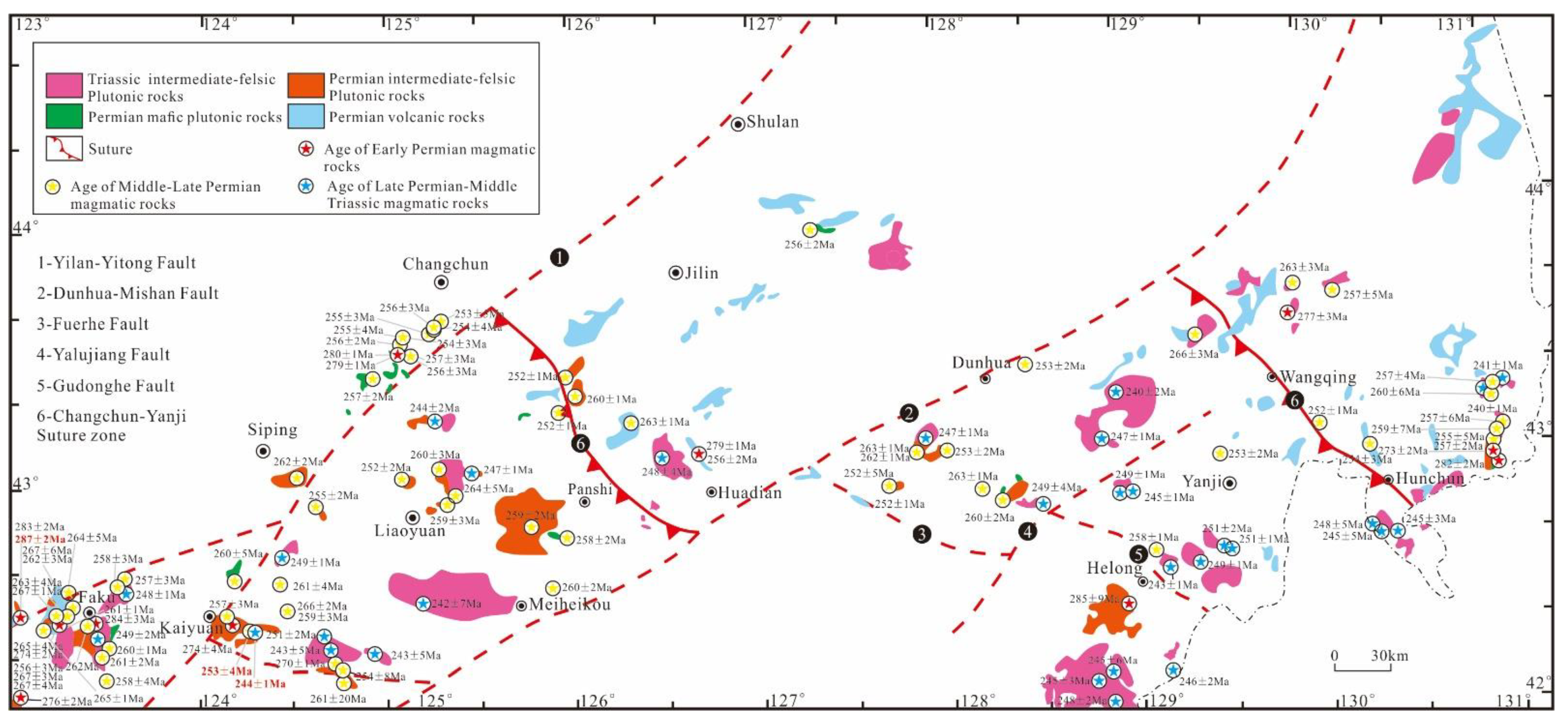
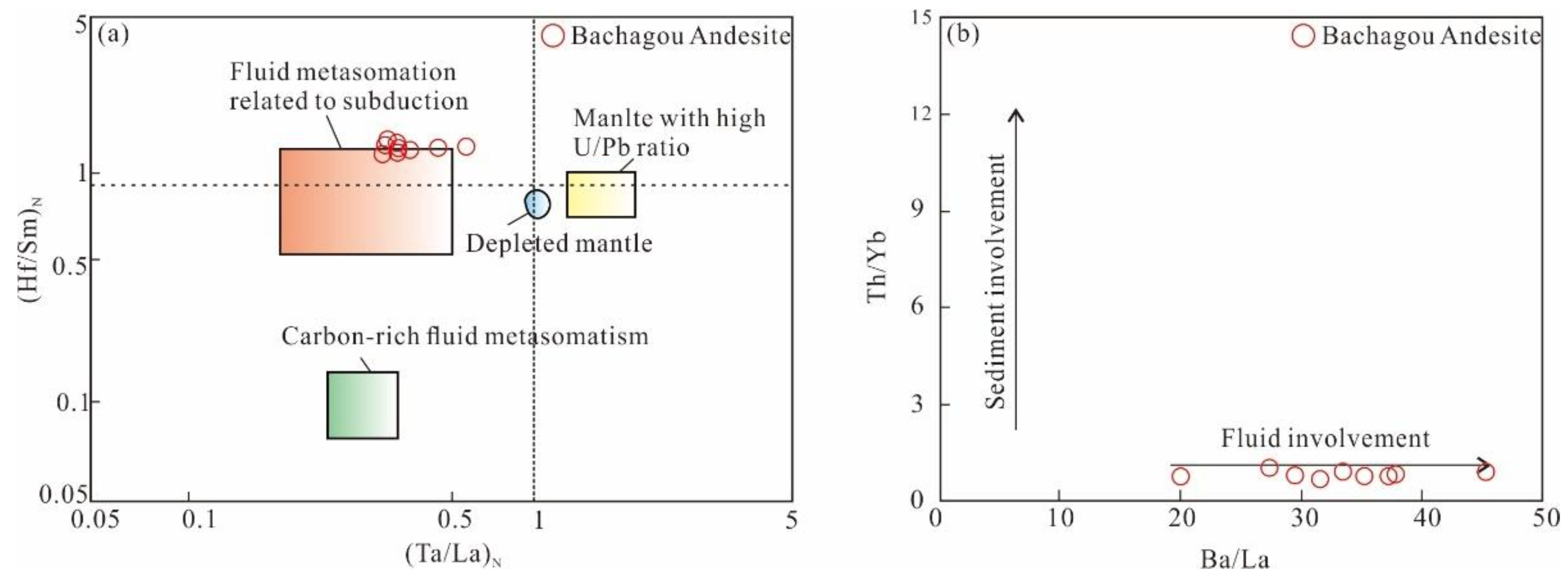
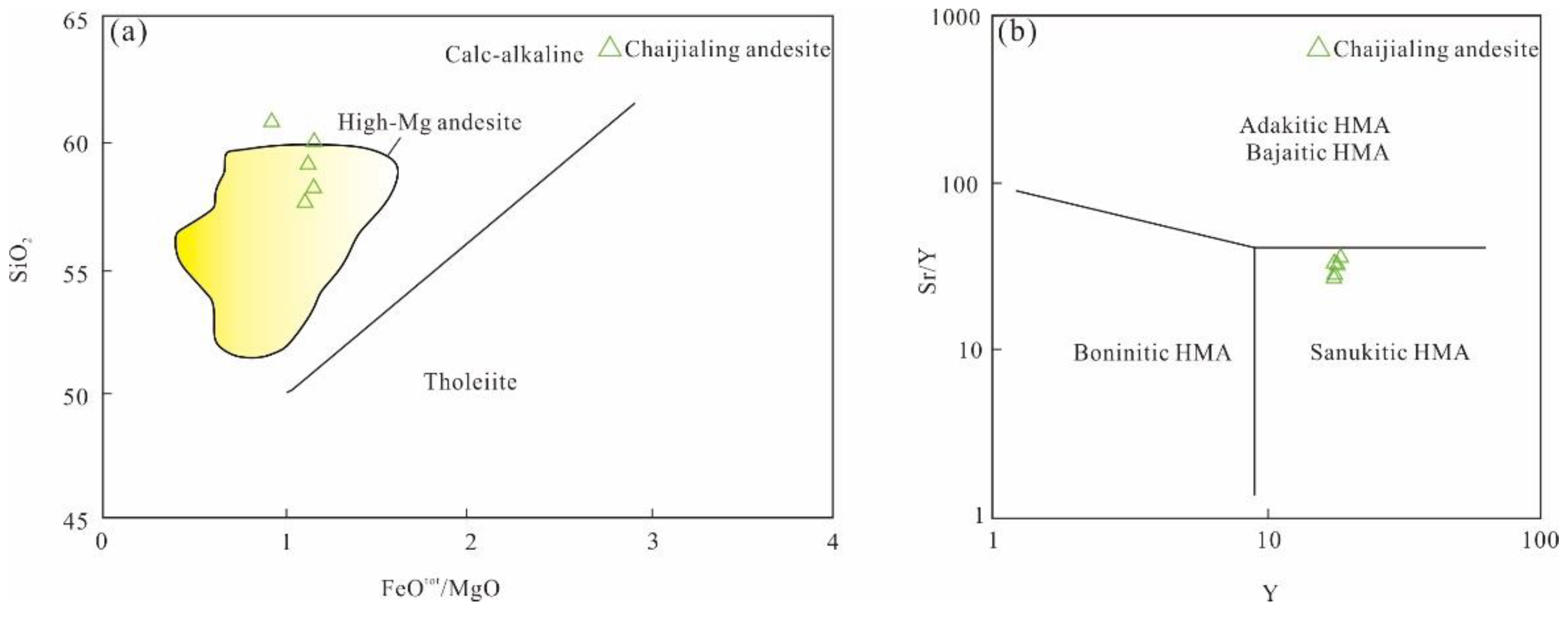
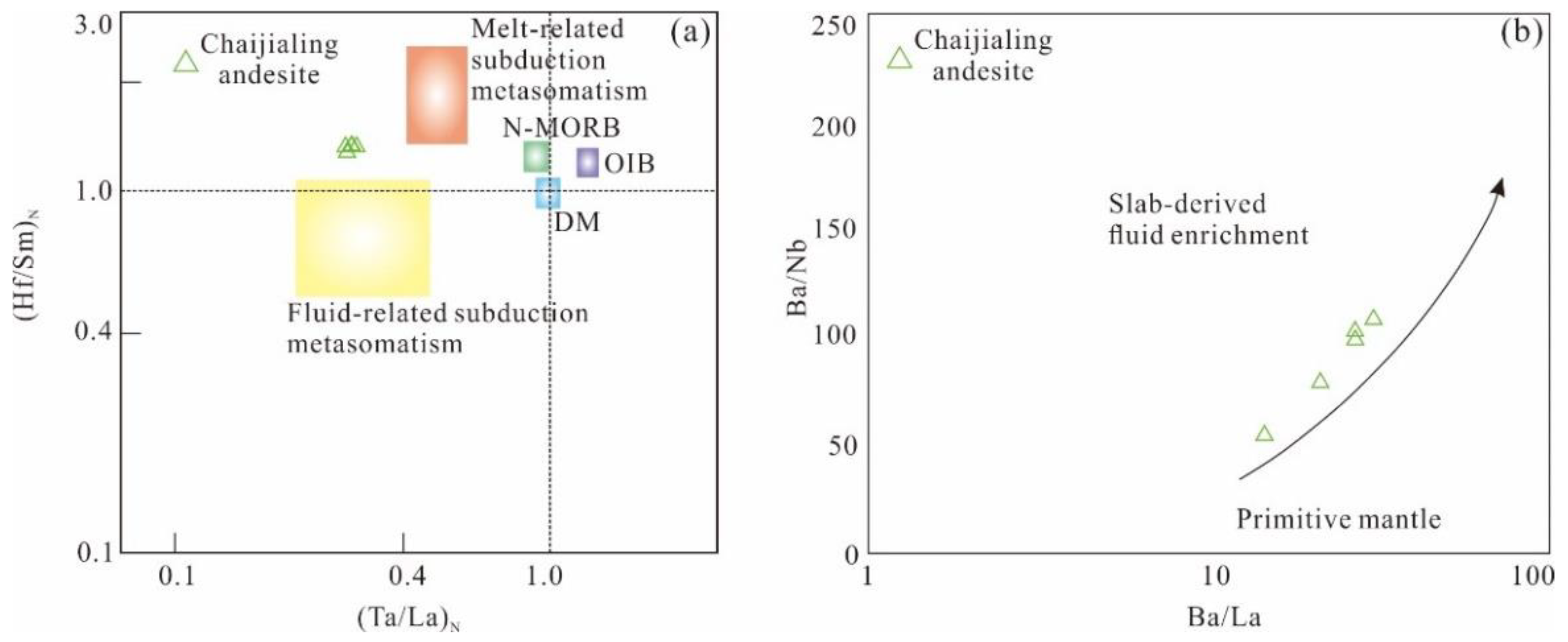
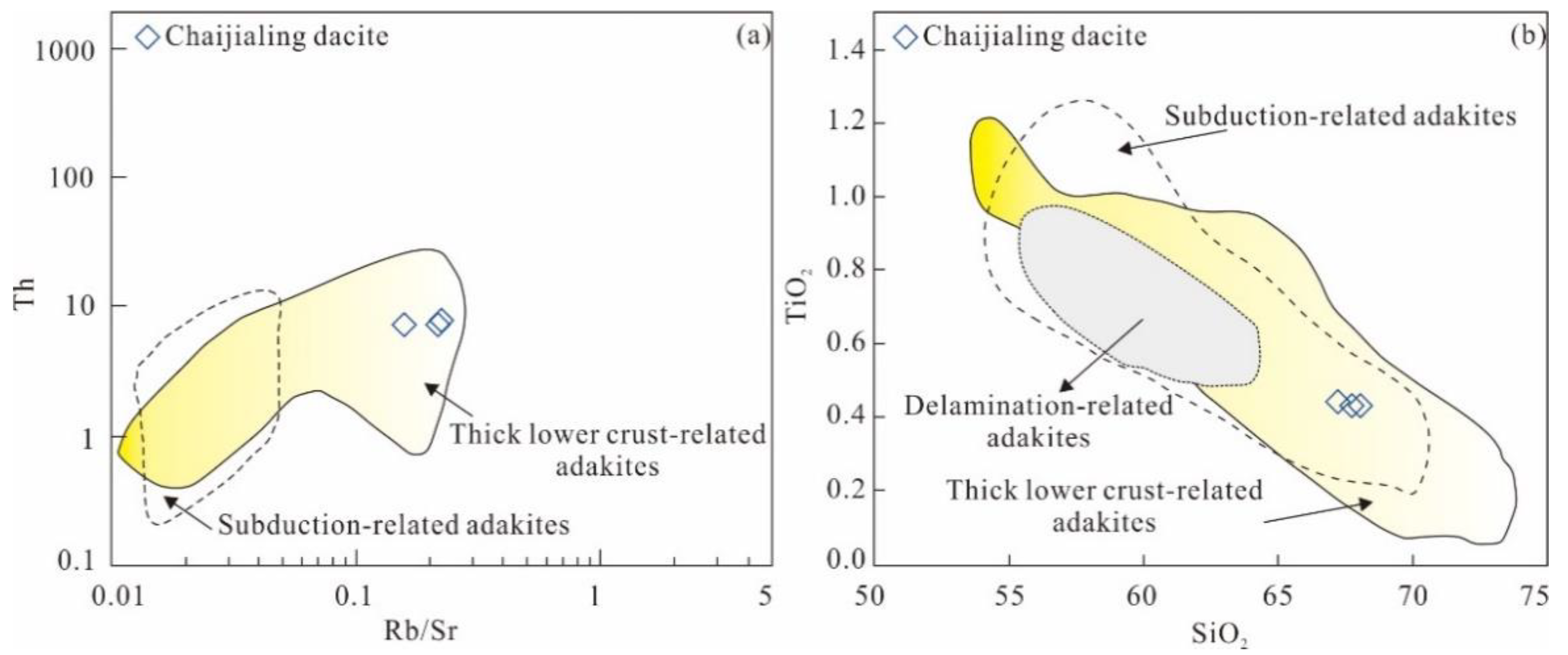

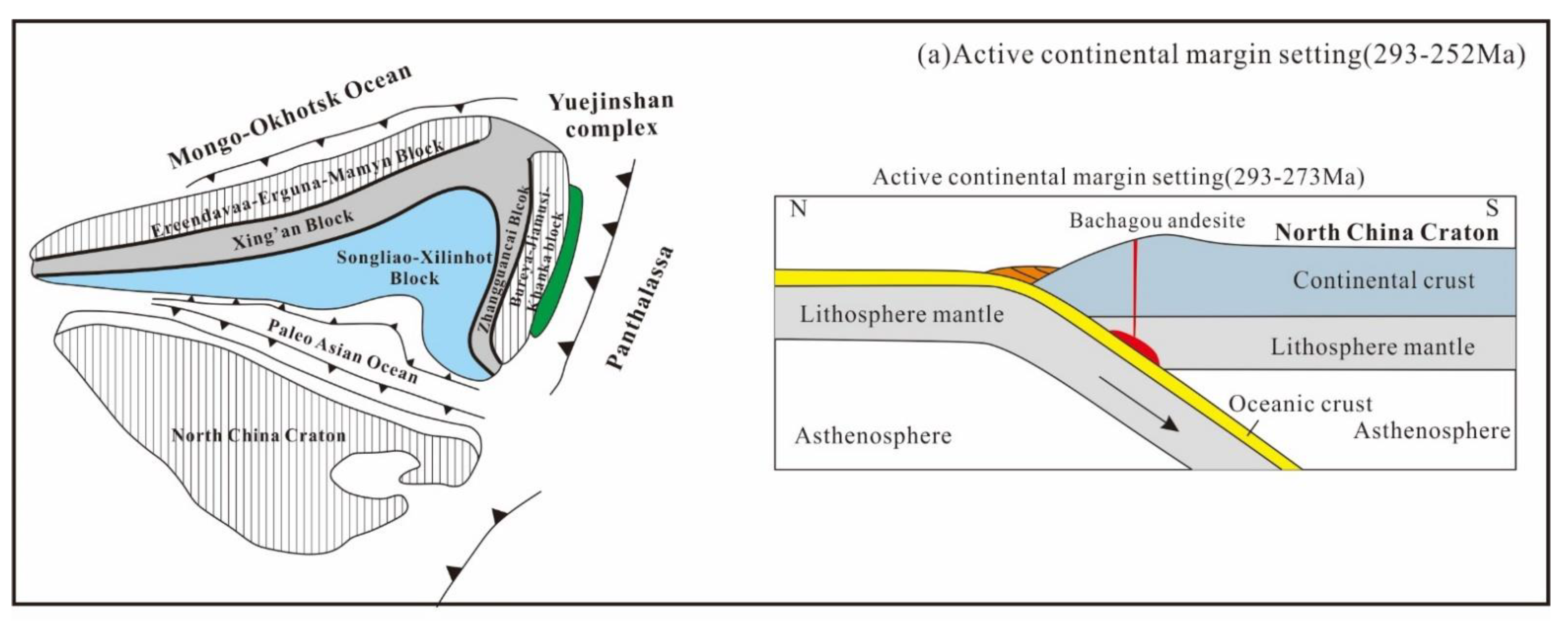
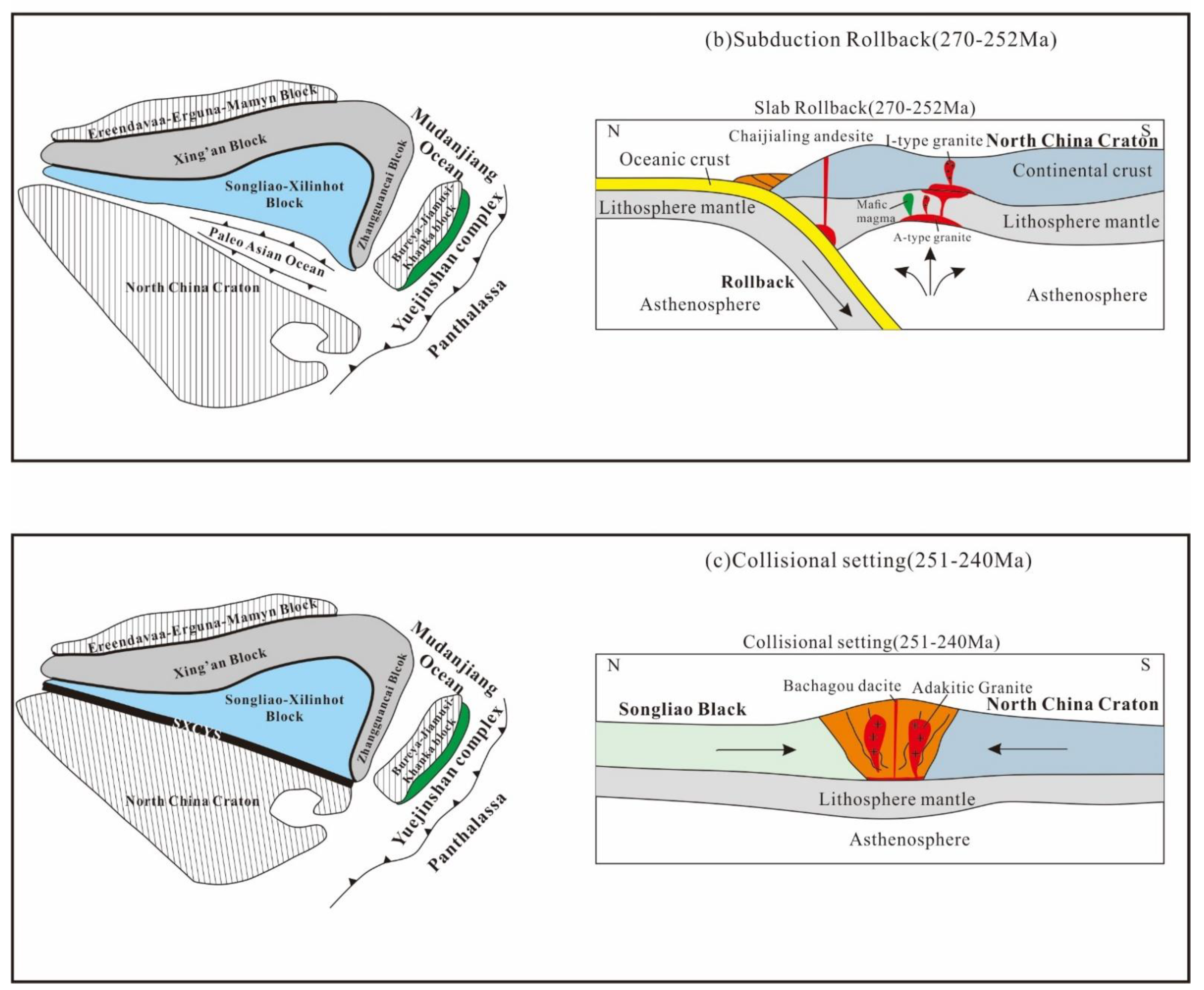
Disclaimer/Publisher’s Note: The statements, opinions and data contained in all publications are solely those of the individual author(s) and contributor(s) and not of MDPI and/or the editor(s). MDPI and/or the editor(s) disclaim responsibility for any injury to people or property resulting from any ideas, methods, instructions or products referred to in the content. |
© 2023 by the authors. Licensee MDPI, Basel, Switzerland. This article is an open access article distributed under the terms and conditions of the Creative Commons Attribution (CC BY) license (https://creativecommons.org/licenses/by/4.0/).
Share and Cite
Xue, J.; Shi, Y.; Liu, Z.; Xue, L. Closure of the Eastern Paleo-Asian Ocean: Evidence from Permian–Triassic Volcanic Rocks in the Northern Margin of the North China Craton. Minerals 2023, 13, 606. https://doi.org/10.3390/min13050606
Xue J, Shi Y, Liu Z, Xue L. Closure of the Eastern Paleo-Asian Ocean: Evidence from Permian–Triassic Volcanic Rocks in the Northern Margin of the North China Craton. Minerals. 2023; 13(5):606. https://doi.org/10.3390/min13050606
Chicago/Turabian StyleXue, Jixiang, Yi Shi, Zhenghong Liu, and Linfu Xue. 2023. "Closure of the Eastern Paleo-Asian Ocean: Evidence from Permian–Triassic Volcanic Rocks in the Northern Margin of the North China Craton" Minerals 13, no. 5: 606. https://doi.org/10.3390/min13050606
APA StyleXue, J., Shi, Y., Liu, Z., & Xue, L. (2023). Closure of the Eastern Paleo-Asian Ocean: Evidence from Permian–Triassic Volcanic Rocks in the Northern Margin of the North China Craton. Minerals, 13(5), 606. https://doi.org/10.3390/min13050606



